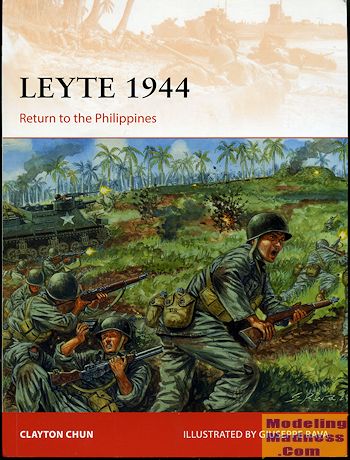Osprey's Leyte 1944
|
Author: |
Clayton Chun, illustrated by Giuseppe Rava |
|
Publisher/Distributor |
Osprey Publishing |
|
Price |
$21.95 MSRP |
|
Reviewer: |
Scott Van Aken
|
|
Notes: |
96 pages, 7¼ x 9¼ inches, softcover
ISBN:978-1-4728-0690-1 |
 The war
in the Pacific was one that, for the army, suffered from several factors. One
was the distance that had to be covered. Unlike Europe where armies had to
travel at most, hundreds of miles, the distances in the Pacific meant thousands.
Secondly, each battle pretty much required an amphibious landing. Third was that
the Pacific theater was not the number one priority of the Allies so frequently
there was insufficent manpower or materiel to undertake the sorts of operations
that they had hoped.
The war
in the Pacific was one that, for the army, suffered from several factors. One
was the distance that had to be covered. Unlike Europe where armies had to
travel at most, hundreds of miles, the distances in the Pacific meant thousands.
Secondly, each battle pretty much required an amphibious landing. Third was that
the Pacific theater was not the number one priority of the Allies so frequently
there was insufficent manpower or materiel to undertake the sorts of operations
that they had hoped.
On the plus side,
the Navy had a greater presence in the area so was usually available for
pre-landing bombardment as well as gunfire support. Then there was the situation
for the Japanese. They tended to believe their propaganda rather than use proper
reconnaissance to determine facts on the ground. If their pilots say they had
sunk the entire American fleet, the Japanese admirals and generals planned as if
it were so. Then the Japanese supply system was pathetic at best. Thanks to US
airpower and submarines, their ability to resupply and move troops dwindled
drastically as the war progressed. Not to say that Japanese soldiers were not
tenacious and inventive, as they very much were, it is just that their situation
could have been better.
So then we have two
commanders in the area, MacArthur who wanted to invade the Philippines and
Nimitz who wanted to invade Formosa and use that to strangle the Japanese supply
lines and therefore their war economy. The wrangling back and forth was
considerable, but MacArthur finally won out once Nimitz realized that he would
not be getting the men, materiel and ships needed for a major operation like
invading Formosa.
MacArthur chose
Leyte as the best place to make a landing as it seemed to be relatively weakly
defended, and that was very true. However, he overlooked the Japanese tenacity
and their ability to supply reinforcements. Even this late in the war, the Navy
couldn't be everywhere and the Japanese were able to bring in considerable
reinforcements during the battle for Leyte. Another was that the invasion was at
the start of the monsoon season and already minimal roads quickly turned into
swamps, bogging down troops and making logistics a real nightmare. It also set
back the time table for getting airfields built as the Navy could not keep
carriers in the area all the time. The 5th Air Force was able to provide some
units, but the lack of prepared fields and the need to abandon some due to the
heavy rains meant that air power wasn't what MacArthur wanted.
The result of all
this was an incredibly difficult campaign to take Leyte and provide a stepping
stone for the later invasion of Luzon. What was envisioned to take weeks took
months and while the results were sometimes in question, the Americans finally
succeeded.
Leyte is one of
those campaigns were most people don't get past the naval battles during the
landings. it had to be one of the more difficult operations that the Army had to
conduct and it resulted in some units shining and others being removed from
combat. It showed that the rest of the war against the Japanese was only going
to get more difficult and that was very much the case.
The story of this
campaign is superbly told and thanks to some great period photos, artwork and
maps, we are able to follow the campaign from beginning to end. It makes for a
great read of what one might consider a 'forgotten' portion of the war in the
Pacific. It was a book that I very much enjoyed reading and one that I can
highly recommend to you.
June 2015
For more on the complete line of Osprey books,
visit http://ospreygrp.com. In the US, e-mail
OspreyUSA@ospreypublishing.com, to request a catalogue of available books.
If you would like your product reviewed fairly and fairly quickly, please
contact
the editor or see other details in the
Note to
Contributors.
 The war
in the Pacific was one that, for the army, suffered from several factors. One
was the distance that had to be covered. Unlike Europe where armies had to
travel at most, hundreds of miles, the distances in the Pacific meant thousands.
Secondly, each battle pretty much required an amphibious landing. Third was that
the Pacific theater was not the number one priority of the Allies so frequently
there was insufficent manpower or materiel to undertake the sorts of operations
that they had hoped.
The war
in the Pacific was one that, for the army, suffered from several factors. One
was the distance that had to be covered. Unlike Europe where armies had to
travel at most, hundreds of miles, the distances in the Pacific meant thousands.
Secondly, each battle pretty much required an amphibious landing. Third was that
the Pacific theater was not the number one priority of the Allies so frequently
there was insufficent manpower or materiel to undertake the sorts of operations
that they had hoped.